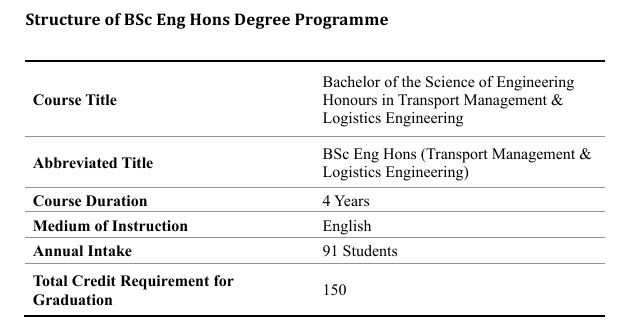 The course modules of the degree program for all four years comprises 150 credits with subject combinations in the categories of Transport; aviation, shipping, public transport, Logistics, Economics, Management, Mathematics, Information Technology, Communication, Skills Development and Other subjects. The course includes a six months full time training in industry, which will be developed in close collaboration with the industry, especially the potential employers.
The course modules of the degree program for all four years comprises 150 credits with subject combinations in the categories of Transport; aviation, shipping, public transport, Logistics, Economics, Management, Mathematics, Information Technology, Communication, Skills Development and Other subjects. The course includes a six months full time training in industry, which will be developed in close collaboration with the industry, especially the potential employers.

Progression of the Curriculum
Semester 1 & Semester 2:

The first year is designed to lay a foundation in the areas of Management, Business Organization, Principles of Transport and Logistics, Computer Systems and Programming, Economics, Mechanics in Transport and soft skills such as Communication and Presentation.
Semester 3 & Semester 4:

The second year builds on the principles by developing skills and techniques and also gathering knowledge in different areas including Transport Economics, Managerial Skills Development, Marketing Management, Accounting, Quantitative Methods, Supply Chain Management, and Transport Planning &Demand Analysis.
Semester 5 & Semester 6:

The third year is designed to ensure that students develop aptitude in each of the specialised areas of transport and logistics namely, Air Transport, Maritime Transport, Supply Chain Management and Transport Systems as well as Management and analytical Skills including a 6 months industrial training.
Semester 7 & Semester 8:

Students are allowed select an area of specialization in Air Transport, Maritime Transport, Supply Chain Management, and Transport Systems during their final year as an option. The objective of this year is to equip the students to enter the world of work by being completely familiar with the issues in the areas of focus areas offered. This is planned through specialised elective courses, multidisciplinary group projects and individual research projects.
Focus Areas :
The Department of Transport Management & Logistics Engineering proposes to offer the following focus areas for Transport & Logistics undergraduates. Depending on the students’ demand and the availability of lecturers, the department will decide what focus areas will be on offer in a specific year.
Learning Management System (LMS)
Students are advised to use Learning Organizer (LearnOrg) and (Moodle) to register their subject enrolments (add/drop), accessing teaching and learning resource materials, interacting with lecturers in submitting assignments and so on.




